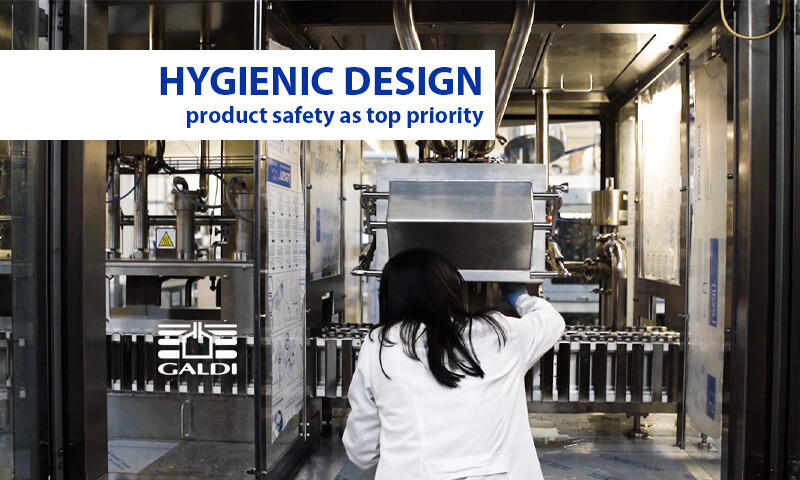Hygienic Design and Food Safety
When designing food filling machines, hygiene and product safety must be top priorities

When designing food filling machines, hygiene and product safety must be top priorities.
In their daily work, Galdi designers follow both:
- the principles of Hygienic Design – complying with European and international guidelines
- the MOCA (Materials and objects in contact with food) regulation – selecting compliant materials and actively cooperating with suppliers and other food chain players to ensure compliance and traceability during the entire life cycle.
Clearly, the goal is not only to meet standards, but also to constantly improve hygienic performance, since careful design enables us to:
- reduce machine downtimes and contamination risks;
- reduce cleaning cycles;
- optimise water consumption and use of chemical compounds for sanitation;
- rationalise electricity consumption.
This translates into more efficient fillers from a hygienic and technical perspective, but also into reducing the total cost of ownership and more sustainability, in line with Eco Design principles.
HYGIENIC DESIGN
The legal framework for the design and manufacture of food machines is the Directive on Machines (Directive 2006/42/EC), transposed and implemented in Italy with Legislative Decree of 27 January 2010.
Designers must also comply with UNI EN ISO 14159:2008 and UNI EN 1672-2:2009 standards, and also with European EHEDG (Doc.8) and American guidelines (3-A).
The above listed standards include the technical requirements for machines in regard to:
Surfaces: machine surface areas exposed to product transit and/or cleaning shall be self-draining and be free from irregular geometric elements that can hinder cleaning and disinfection.
Joints: junction points shall be free from crevices that would make cleaning more difficult and increase the risk of contamination.
Welding: welded surfaces shall be non-porous.
Screw threads: screws in critical filling areas shall be free from exposed threads, in order to prevent dirt and microorganisms from accumulating. Wherever possible, welding is to be preferred. Furthermore, there shall be no screws in the area above open packages, to prevent metallic parts from entering into the packaged product.
Sharp edges: components, especially those in contact with the product – e.g. cleaning section pipes – must be rounded and curved to facilitate cleaning.
Construction materials: due to its greater durability and easy cleaning, stainless steel is always to be preferred, also because it is inert and releases a very low amount of potentially dangerous substances. Plastic components must be selected according to the food product and the thermal stress resulting from filling.
FOOD CONTACT MATERIALS (MOCA)
Food contact materials deserve a special section, given their importance for food safety.
These materials must fulfil strict requirements:
- they shall not change food composition, altering organoleptic properties;
- there shall not be a migration of organic, inorganic or chemical substances from and to the food product;
- they must be resistant to corrosion and to the action of detergents and disinfectants;
- they must remain inert to food, even under the most severe conditions of use, during the entire life cycle.
The main European legal frameworks for materials intended for contact with food are Regulation (EC) n. 1935/2004 and Regulation (EC) n. 2023/2006, which lays down the rules on good manufacturing practice.
In Italy, Ministerial Decree of 21 March 1973, with later amendments, also applies. The decree defines authorised materials, overall migration limits and mandatory declaration of conformity to guarantee the whole production chain.
For the US market, FDA-compliant compatibility guidelines must be followed as well.
CURRENT AND FUTURE DEVELOPMENTS
The compliance with Hygienic Design requirements and the improvement of the filler's hygienic performance go hand in hand with the machine's improved efficiency and reliability performance.
In order to achieve this three-fold result, the key words are: research, development, prototyping, tests...and more research!
Galdi constantly tests its systems, particularly focusing on the cleaning and sanitation processes of its packaging machines.
Besides testing the efficiency of CIP, SIP and External Cleaning systems, Galdi also evaluates new design solutions and conducts technical and machine tests.
In the packaging machines with the highest hygienic standards – Ultra Clean configuration – further analyses and improvements are under way to increase the performance of the hygienic chamber, to maintain high hygienic standards from package disinfection to final sealing.
The goal is also to reduce manual cleaning operations, by automating processes, while minimising operations carried out by operators and maintenance technicians, who could compromise the hygienic standards guaranteed by the system.
Clearly, design is only one of the aspects Galdi focuses on to ensure food safety. Our customers can also rely on technical support, specific training, many validation tests, and, of course, prompt and effective assistance!
